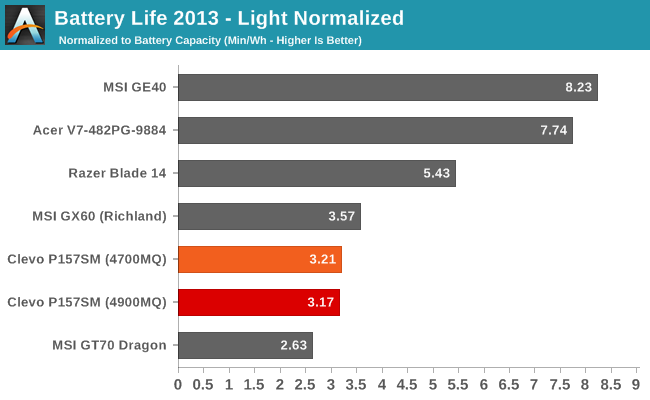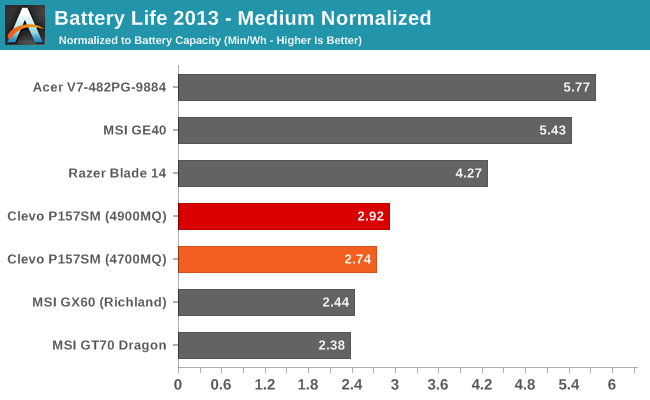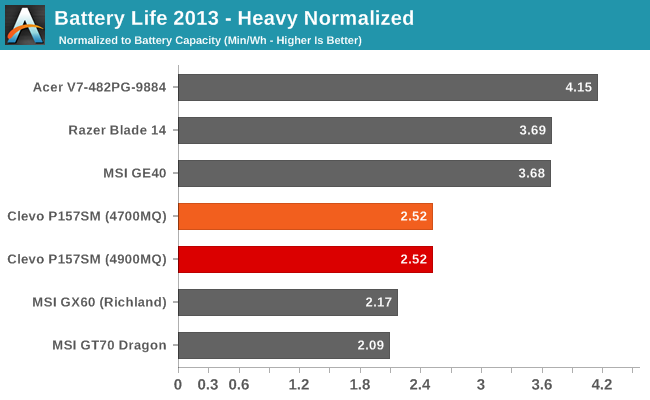Mythlogic Pollux 1613 / Clevo P157SM Review
by Jarred Walton on August 30, 2013 12:00 AM ESTMythlogic Pollux 1613 / Clevo P157SM Battery Life
If there’s one weak spot in terms of objective measurements with Clevo’s gaming notebooks, it’s almost always battery life. Regardless of what power profile or other settings you might use, it’s simply not as good as what we’ve seen with gaming notebooks from other vendors. Most of this is due to the tuning of the BIOS/firmware with a focus on performance rather than power efficiency.
The scores in the charts below include our initial testing results from the MSI GT70, but as one example of what’s possible with further BIOS tuning, with an updated BIOS I measured 373/286/224 minutes on a GT70 – that’s a 63% improvement in our Light testing, a 38% improvement in our Medium testing, and a 23% improvement in our Heavy testing. Performance (gaming performance in particular) dropped slightly in most titles along the way, but reducing performance by a few percent to get significant increases in battery life is definitely a worthwhile compromise on a notebook. Whether or not Clevo can duplicate that feat with an updated BIOS remains to be seen, but past experience isn’t very encouraging.






The good news is that battery life is still better than what MSI achieved with our initial sample, but it’s a far cry from what we’ve seen with other laptops. MSI’s GE40 in particular delivered some stellar results, with relatively similar hardware all told (other than the smaller and lower quality display). Keep in mind that for all of these tests, the discrete GPU is inactive, so we’re only looking at the power and battery life with the iGPU and other components. Also interesting to note is that the choice of an i7-4700MQ or i7-4900MQ doesn't appear to impact battery life much at all.
I’m always asked for battery life while gaming, so I did run some tests there as well. First, as with most gaming notebooks, the dGPU throttles pretty heavily under load. I looped 3DMark11’s demo at 1366x768 “Performance” settings until the battery went dead, and frame rates were around 30-50% of what you’d get while on AC power. The GPU clocks in a game are 850MHz+ on the core and 5000MHz on the GDDR5; unplug the notebook and the core clocks drop to 405MHz while the RAM drops to 1600MHz – not that you need 5000MHz RAM to feed a 405MHz core, but it’s still a major castration of performance under battery power. What that means is that you can actually get nearly the same gaming performance on battery power from the Acer V7 with its GT 750M (which doesn’t throttle as much), or the MSI GE40 (again, less throttling).
Battery life of course is going to be better than if you were running the GPU full tilt, but even with the reduce clocks the P157SM only manages 75-80 minutes before the battery is drained. Put another way, unplugged and running a game the P157SM draws about 63W. Plugged in, I measured 185W power draw at the outlet, so even if we assume an 80% efficiency power brick (and hopefully it’s better than that), the laptop is using around 150W when plugged in, or more than twice as much power. Would someone be happy to get twice the performance but less than half the battery life with a gaming notebook? I doubt it, so the decision to throttle the GPU clocks on DC power is probably the right thing to do.










47 Comments
View All Comments
Khenglish - Friday, August 30, 2013 - link
It is strange that in some cases you had lower performance overclocked than not. Did you raise the TDP limit when you overclocked the CPU? I have found hitting the TDP limit to cause the CPU clocks to periodically plummet on my P150EM, hurting performance substantially.Ex 1:
CPU is set to 3.8ghz, using 55W of power. CPU runs at 3.8ghz constantly, but only 3.5ghz is needed to max out the GPU in whatever game is being played at this time.
Ex 2:
CPU is set to 4ghz which requires the TDP to be over 55W. CPU usually runs at 4ghz, but every 10 seconds plummets to 2.6ghz. Since this particular game only needs a constant 3.5ghz, there is a performance loss.
JarredWalton - Friday, August 30, 2013 - link
Yeah, in the BIOS I set it for 67W I believe. I don't know how much that affects things, but something else is clearly going on. GRID 2 in particular is very consistent with its odd behavior.Khenglish - Friday, August 30, 2013 - link
Didn't you say that one of the MSIs came with a 4930mx? You could pop that into the P157SM, set the TDP sky high, set the same clocks, and see if it has the same odd behavior.And upon taking off the clevo CPU heatsink you will see that they crush the heatpipes onto the heatsink plate, warping the plate raising temps by 10C+ (I lapped the plate on my P150EM). You can see stress marks in the plate directly under the heatpipes. GPU plate has the same problem. Clevos would have phenomenal cooling if clevo fixed this.
JarredWalton - Friday, August 30, 2013 - link
The MSI systems had to go back to NVIDIA (for PAX), so I don't have them any longer. I'm not sure there's that much thermal headroom on the P157SM anyway -- temperatures notwithstanding, the 4900MQ overclocking is clearly hitting some limit that's preventing maximum performance.Moooza - Friday, August 30, 2013 - link
I've been seriously considering the P150SM. Any real downsides in your opinion compared to the P157SM? I like the smaller size and that stupid touchpad light isn't present.I have been considering the exact same spec you reviewed (thanks by the way), but with 4x4gb 1866mhz RAM.
JarredWalton - Friday, August 30, 2013 - link
If you're okay with the single 2.5" drive, I don't know that there's anything wrong with the P150SM. Given the touchpad and a few other aspects, I'd probably go that route myself if I were in the market for a gaming notebook... well, that or I'd opt for the larger P170SM.cmikeh2 - Friday, August 30, 2013 - link
All units of the P150SM I've found only had 120W power adapters. Do you see that as an issue?DanNeely - Friday, August 30, 2013 - link
XoticPC defaults to a 180W with the P150SMcmikeh2 - Friday, August 30, 2013 - link
My bad I totally blanked there.. You're right. I was conflating P150SM with P151SM1 for some reason.Khenglish - Friday, August 30, 2013 - link
180W is still too weak for overclocking. The 17 models come with a much more appropriate 220W PSU (which also can be too weak with heavy overclocking, but far better than 180W). I don't know why clevo chooses to gimp the 15 inch models with the smaller PSU connector and 40W weaker PSU.